AFEP MARINE Evolution
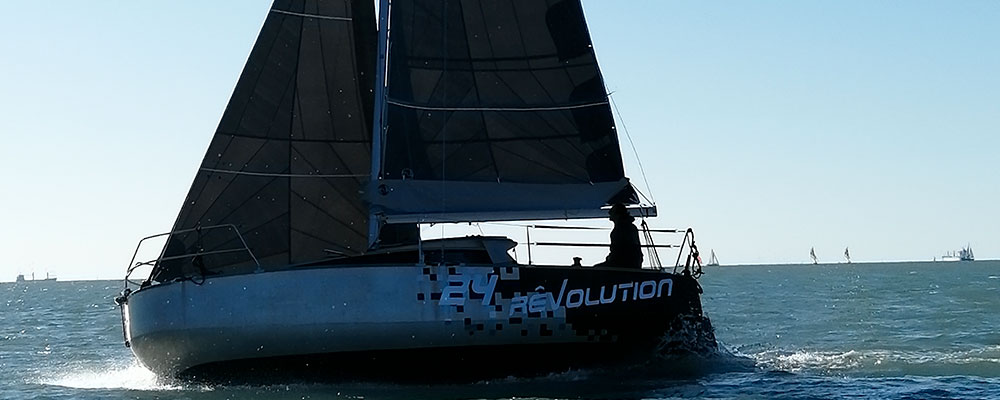

Les caractéristiques du Rêvolution 22
Équipements.
TARIFS ET ÉQUIPEMENTS 2012 : 49 400 € Tarif TTC en euros, départ chantier La Rochelle
ÉQUIPEMENT STANDARD
Coque et pont aluminium (6, 5 et 4mm) Déco autocollante (couleur au choix) Primaire œuvres mortes + 2 couches primaire époxy Revêtement pont et vaigrage : liège projeté (couleur au choix) 2 safrans + 1 quille relevable avec bulbe plomb 1 baille à mouillage + davier et 1 taquet 2 rails de fargue aluminium anodisé
1 mât aluminium Gréement dormant et courant 1 bôme 1 grand voile full batten dacron 19,5 m2 à corne 6 lattes 2 ris automatiques 1 foc dacron 13,5 m2 2 rails et chariots foc Harken 3 winchs HARKEN ST20 1 palan de GV Harken et rail Harken 1 hale bas de bôme 1 descente plexiglass + porte 4 taquets de pont
1 balcon avant inox diamètre 23 2 balcons arrières inox diamètre 23 6 chandeliers et doubles filières 2 hublots latéraux fixes 1 hublots ouvrants (toilette) 4 bloqueurs lewmar sur roof 2 poulies de ris automatiques Harken sur mât
1 carré : 1 table, 5 dossiers et assises tissus silvertex (couleur au choix), transformable en 2 couchettes (1,95m x 0,7 m) 1 coin cuisine : 1 évier + réservoir souple 55L + robinet pompe manuel + réchaud à gaz sur cardan 1 cabine arrière : couchette double (1,95m x1,95m) avec matelas tissu Silvertex (couleur au choix) 1 Cabinet de toilette avec WC chimique et porte coulissante
1 enrouleur de foc + accastillage 1 lazy bag 1 Sac à drisse 1 spi asymétrique + accastillage Harken 1 bout dehors pour spi asymétrique
Équipement sécurité moins de 6 milles : 1 échelle 6 gilets de sauvetage Storm 100N 1 lampe torche hallogène 1 bouée couronne avec feu retournement 1 miroir de signalisation 1 gaffe + 1 aviron + 1 dame de nage 1 pavillon français 1 compas cloison 1 mouillage complet 1 boule mouillage + 1 cône noir 3 feux de détresse automatiques à main 20 m amarres polyester D10 4 pares-battages
Pack électricité et électronique : sur devis Hublots supplémentaires 1 panneau de pont lewmar (47,6 x 47,6 cm) 1 hublot cabine arrière lewmar
Pack moteur 1 Moteur Mercury F6ML arbre long 1 nourrice 1 chaise moteur
Carré transformable 2 coussins couchette double 1 système adaptation
> Voir la documentation du Rêvolution 22 en PDF <
Rêvolution 22 nouvelle génération.
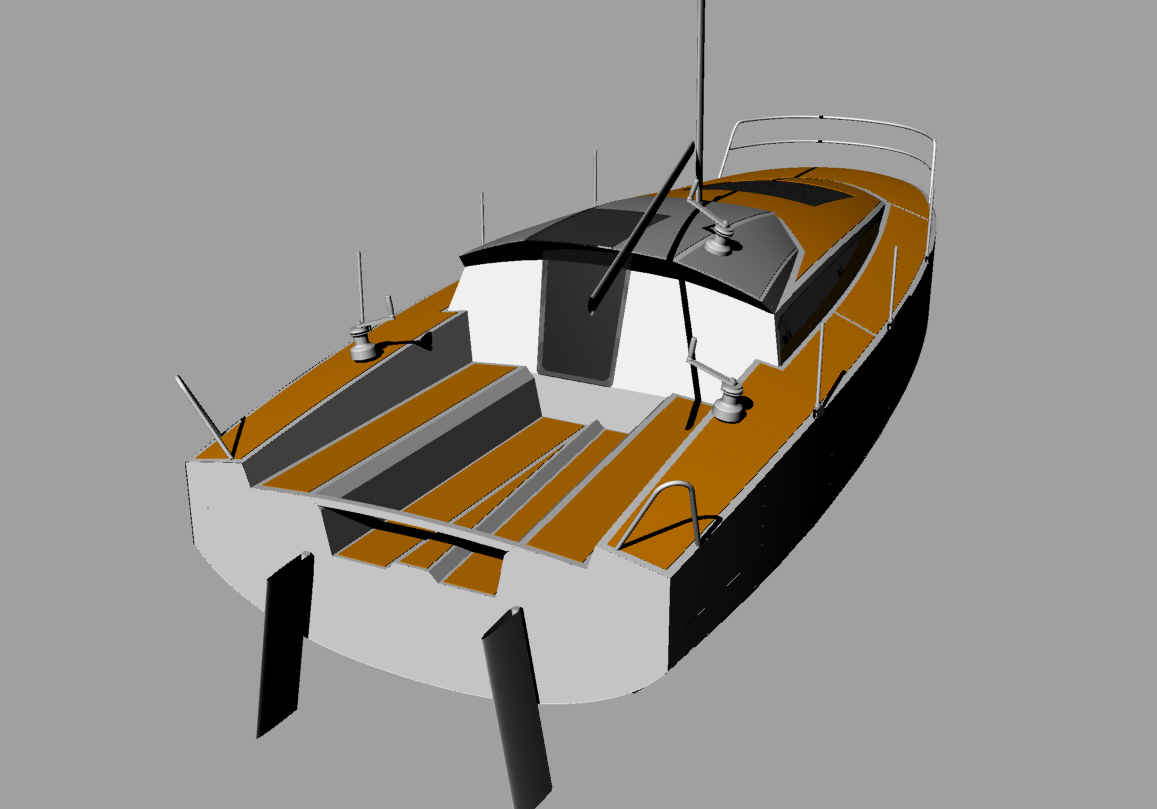
Un cockpit spacieux Afin de vivre autant à l'intérieur qu'à l'extérieur, le Rêvolution 22 possède un cockpit de taille plus que généreux pour cette longueur de coque : 2,45 m de long par plus de 2,8 m de large. Du jamais vu dans cette catégorie. Il est équipé de coffres sur toute la longueur tribord
Solidité et facilité d'entretien
Le Rêvolution 22 est construit en aluminium semi épais : 6 mm pour la coque et 5 mm pour le pont et le roof. Cela fait du Rêvolution 22 un voilier qui n'a peur de rien. Résistant, solide et léger, l'aluminium est le matériau idéal pour un voilier de croisière. Pour la sécurité, une crash box est présente à l'avant, formée par la cloison étanche.
Rarement utilisé dans cette taille de bateau, car souvent trop cher par rapport à un bateau de taille équivalente en polyester, l' aluminium semi épais est sans doute le meilleur matériau à tous points de vues. AFEP Marine a donc mis en place des processus et des innovations en matière d'aménagement intérieur qui permettent au Rêvolution 22 d'être proposé à un tarif similaire à celui d'un voilier en polyester de la même catégorie.
Le Rêvolution 22 a une coque en aluminium semi épais et un revêtement de pont et de vaigrage intérieur en liège projeté . Étanche, antidérapant, anticondensation, antihumidité, isolant acoustique et thermique, le liège projeté permet au Rêvolution 22 d'être un bateau confortable et pratique.
Le liège projeté se nettoie avec un balais brosse ou un nettoyeur haute-pression et ne demande aucun entretien particulier. Avec l'aluminium qui ne demande aucun soin courant, le Rêvolution 22 est un voilier simple et fonctionnel. Fini les corvées d'entretien, profitez de votre bateau pour naviguer...
Un voilier passe partout... avec des sensations de glisse nouvelles
Le Rêvolution 22 ne ressemble à aucun autre bateau de plaisance classique.
Grâce à David RAISON et à son expérience sur un bateau similaire, le Rêvolution 22 donne accès à des sensations de navigation inconnues jusqu'à présent.
Cette carène puissante, avec sa largeur maximum donne un bateau avec une grande raideur à la toile, de quoi amuser les plus exigeants des navigateurs et à rassurer les pères.
Avec sa taille raisonnable, sa quille relevable et ses doubles safrans , vous pouvez gagner les endroits les plus reculés pour échouer le bateau sans peur d'abîmer sa coque en aluminium semi épais.
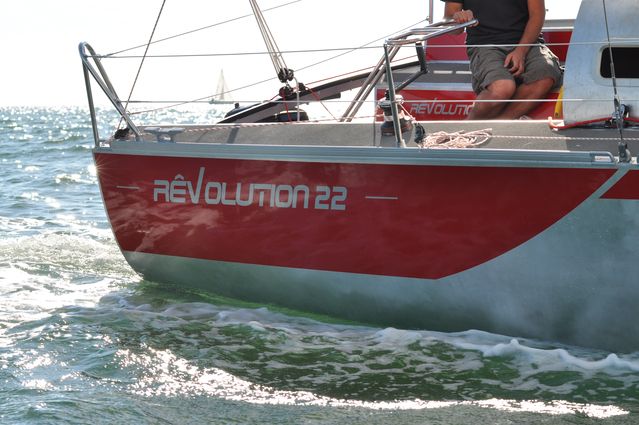
Une personnalisation à l'infini
Longévité et écologie.
L'aluminium épais et le liège , connus depuis de nombreuses années pour leurs qualités intrinsèques et leur durabilité, sont des matériaux en perpétuelle évolution, tant dans leurs mises en oeuvre que dans les nouvelles applications développées.
Longévité Les bateaux en aluminium, plus solides, résistent mieux dans le temps et possèdent une durée de vie plus longue que des bateaux en polyester ou en bois. Le liège projeté est un matériaux naturel qui résiste bien dans le temps. 100% étanche à l'eau et 75% respirant, le liège projeté ne provoque pas de zones humides même s'il y a des infiltrations. Il est donc imputrescible, pas la peine de penser à refaire les vaigrages ou le pont tous les 10 ou 15 ans comme avec des matériaux classiques.
Écologie La récolte du liège ne nécessite jamais l'abattage des arbres protégeant ainsi les forêts où ils sont élevés. La forêt de liège fixe plus de 20 millions de tonnes de carbone par an. Le liège respecte le concept de durabilité, connu comme le Triple Bottom Line produit du développement économique, développement social et le développement environnemental.
On sait que l’aluminium demande beaucoup d’énergie pour sa fabrication, mais qu’il est recyclable à 100% et avec très peu d'énergie. La durée de vie d’un bateau en aluminium épais est estimée à au moins 60 ans.
Le liège projeté peut prendre la couleur souhaitée par le propriétaire qui peut ainsi donner à son bateau une personnalité unique aussi bien au niveau du pont qu'au niveau des couleurs des vaigrages. Quand à l' aluminium , il est le matériau idéal pour répondre à toutes les envies des futurs propriétaires des voiliers Rêvolution.
Chaque Rêvolution 22 sera unique par ses couleurs et ses personnalisations d'aménagements.
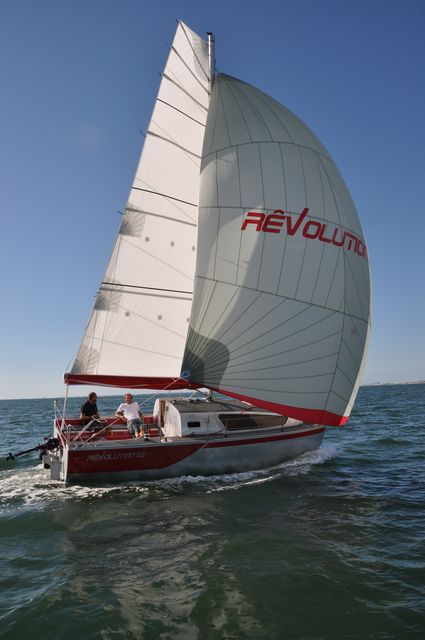
Mention Légales - Création PLUSCOM

- News & Views
- Boats & Gear
- Lunacy Report
- Techniques & Tactics
CRUISER-RACER CONFUSION: Scow Bow Revolution 29 and Gunboat G4 Capsize
This is something I ask myself quite often: can a modern truly cutting-edge high-performance racing sailboat also be a cruising boat? In certain ways, of course, the old ideal of the true cruiser-racer, per the glory days of the Cruising Club of America rating rule and boats such as Carleton Mitchell’s famous yawl Finisterre , evaporated many decades ago. Yet still it is an ideal that both boatbuilders and boat owners incessantly aspire to somehow realize in a modern context, and it is fascinating to watch how these aspirations manifest themselves. Take, for example, the Revolution 29 (see image up top), a new cruising design developed in France that is directly based on David Raison’s radical scow-bowed Mini 6.5 in which he won the Mini Transat in 2011.
Raison’s Mini was not just radical in appearance; it was radically fast and won the 2011 Transat by a large delta, setting a new course record in the process. This success was so significant that other important monohull racing classes—Open 60s, Class 40s, TP 52s—pretty quickly banned scow bows for fear their existing fleets would instantly be rendered obsolete. Development of the concept continues however within the Mini class, which has long been a leading hotbed of high-performance monohull sailing innovation.
David Raison arrives in Brazil aboard TeamWork Evolution in 2011 after crushing the rest of the Mini fleet
What’s interesting about the scow bow, of course, is that it is one of those few racing innovations that immediately and obviously has critical advantages in the cruising market. As in: if you make the bow of any boat much wider you have lots more space inside for accommodations.
Interior of the Revolution 29. A whole lot of space for a boat this small. Note there is also a predecessor design, the Revolution 22, more directly based on the 22-foot racing Mini
But putting a scow bow on a cruising boat obviously doesn’t instantly make it a “cruiser-racer.” What makes the scow bow super-competitive is that it facilitates a boat’s ability to plane, and the other key factor in that equation is always weight. Or rather the lack of it. Load up a boat with lots of furniture and gear and you will seriously inhibit its ability to plane regardless of what shape its bow is. As always, a certain balance must be achieved and compromises must be made.
To get an idea of what a competitive scow-bow boat looks like under sail, watch this viddy here of TeamWork Evolution drag-racing against a conventional Mini.
You should note in particular the boat’s insanely huge sail plan. Prototype Minis are renowned for these, and obviously the rig on any reasonable cruising boat would want to be quite a bit smaller. One question in my mind is whether you in fact need all the extra sail area to make the scow bow fast. Could it be that with more cruiser-sized sails the scow bow might actually be slower than a conventional bow?
The new G4 does its flying thing
Another question being openly discussed right now, thanks to Gunboat and its new G4 foiling catamaran , is whether foils make any sense on a “cruiser-racer.” As I mentioned in my previous post on the boat, it is the first fully foiling boat with any sort of accommodations, and Gunboat has been marketing it as a coastal cruiser-racer. And now in its racing debut at St. Bart’s the svelte little beast has capsized in dramatic fashion, which has prompted some forum trolls as well as a few otherwise polite people to wonder out loud how this could possibly be termed a cruising boat.
Wipe Out from Gunboat on Vimeo .
Watch the viddy here first and then ask yourself: did the boat capsize because it was foiling, or did it capsize because the crew was unable to release the mainsheet for some reason? To me it definitely looks like the latter and that this would have happened, given the issue with the sheet, to any performance cat whether it was airborne or not.
Actually in this image it looks like that helicopter might have been a precipitating cause
Gunboat CEO Peter Johnstone, post flip
So maybe we shouldn’t be focussing on the foils so much. After all, as I understand it the G4 was originally developed as a straight performance cat and the flying foils were added later in the process. Like the AC72s in the last America’s Cup go-round, the G4 wasn’t born a foiler, but evolved into one. Also, of course, it is perfectly obvious that the boat capsized because it was being raced and not cruised. The crew was pushing the boat to its limits, and just because it has a limit (like any boat) doesn’t mean it can’t be cruised. For example, I have a friend who once owned a heavy full-keeled Tayana 37 that was dismasted during a distance race because he declined to take his spinnaker down when conditions got strong. The spinnaker in a gust just pulled the mast right off the boat. Which obviously doesn’t mean you can’t go cruising in a Tayana 37.
I think the real question to ask is: is there a point at which a boat becomes too performance-oriented to really be termed a cruiser? Which really is just another way of asking: what exactly is a cruiser-racer?
Back in the days of Carleton Mitchell and the very conservative CCA rule it was a pretty simple concept. A cruiser-racer was a boat designed to cruise that you could also race, and basically all you had to do to do that was take a ton of crap off the boat and—if you were very serious—bend on different sails. Back in those salad days, that was all it took to be competitive at the highest levels of racing.
These days there are many more variations of the species. There is a vast universe of older boats racing mostly under the PHRF rule in local beer-can series that are very obviously cruising boats that are being raced just for fun. We have a few what I call “captive venues,” the best example being Swans, where there is a small universe of very active racing focussed usually around a brand, where an honest-to-God cruising boat can engage in some pretty serious racing with other cruising boats. We have fancy expensive “performance cruisers” with luxurious interiors that can be raced if desired with minimal changes to the boat (this is pretty much the category the larger Gunboat cats fall into). We have a few even more insanely expensive performance cruisers with wholly interchangeable interiors for both cruising and racing. (I have even seen boats with interchangeable keels!) We have various folding trimarans with cramped accommodations that can be raced in various events. We have families with small children cruising around the world in modified open-class ocean racers. We have “buckets” where enormous super-yachts, obviously designed for cruising in the most obscenely opulent sense of the term, can race against each other.
And on and on and on. The market for sailboats that can be both raced and cruised has become so complex and variegated it is impossible to say where it begins and ends.
Really the only advice I can give to help make sense of this spectrum is that the terms “cruiser-racer” and “racer-cruiser” should not be used interchangeably. Rather we should agree on two specific definitions. As in a cruiser-racer is a boat designed to cruise that can also be raced, and a racer-cruiser is a boat designed to race that can also be cruised.
The G4 I think is certainly a racer-cruiser, and perhaps to some it is an extreme example, but I for one would be very happy taking it out for a week’s worth of high-octane gunkholing.
IN OTHER DEVELOPMENTS: There’s some buzz on the Sailing Anarchy forums that the Gunboat 55 Rainmaker , abandoned after being dismasted back in January , has been spotted again, afloat, but with her coachroof torn away (remember, this is an open-bridgedeck boat, the roof is merely shelter). There’s even one guy claiming the boat has been towed in somewhere, but so far there’s no confirmation of this. I have heard confirmation of the boat’s being spotted, and of the damaged coachroof, from the boat’s designer Nigel Irens via third parties.
Related Posts

CRAZY CUSTOM CRUISING BOATS: New Rides for Pete Goss and Barry Spanier

JAMES WHARRAM: His New Autobiography
The scow bow helps the boat surf, especially sailing off the wind. But how is it beating into steep seas?
@Damon: That is the question, for sure. Even if it’s still fast to windward, I bet it’s not exactly comfortable. One advantage of the shape is the waterline area is likely very symmetrical when the boat is heeled, but I guess the bow must pound something fierce.
I think the answer to your question is, yes.
This type of fast – cruising, would be different than what cruising has evolved into since the Finessterre days.
Today, cruising can mean a life choice/commitment of living for decades on a sailboat. The cruising sailboat that must serve as a home at sea has evolved into a complicated and commodious(and expensive), vessel.
To cruise in a high performance boats like you’ve posted, means going light. Backpacking as compared to RV-ing. The speed could be a whole new adventure and lure for younger sailors. But it will come at a cost of comfort and maybe will become less of a time commitment, as back packing is(not many backpack open-ended, for decades).
It appears less people today are jumping into the life choice cruising mantra of the 60’s and 70’s. Yet sailing is as popular as ever with young and old(around me).
I see this notion of a lighter, smaller, faster(cheaper), sailboat on a ‘sail’, as having appeal to a new generation of sailors my kids(and their friends) age, as they grow into a life(and the means), that includes sailing.
Speed is good and will take skill to tame(I love 4kts)!
I have cruised and raced my light, go fast boat for 25 years, loved every minute.
I am drawing a 42′ idea, 14′ beam, looking at 10-12 as a good speed for us elders (me 69, she 66). assy lee boards, unstayed rig, two winches, lots of hatches and deck openings. I built an Atkin Ingrid in 1969-74 and sailed her from San Fran to NZ. As a sailmaker who raced 5O5 at WC level for awhile, the slowness and poor performance upwind of that double ender shape was always tough to trade for some speed. not to mention low and wet. When i hitched a ride from Tahiti to Maui on a Cal 39 it really showed me how nice the speed could be for comfort as well. Better wave synch etc.
thirty years of windsurfing speed and early foiling tri’ experience (Longshot) leave a deep impression about how fast we can go… but 10-12 will do for this stage of my ocean travel dreams. plus, samantha isn’t comfortable with the whole concept yet. got to make it comfy. our Westsail 42 is growing on her, and she’s getting used to that scale of living aboard .
thus, i’d love to hear from anyone who has had some experience with these shapes in head seas. i’m right there with the french concept. so happy to let them find out these things before my paper becomes a boat.
bob johnstone sailed the grot baer across oceans. he probably wasn’t in a hurry. but he must have been comfy enough. if you are truly voyaging, and not sight seeing on a plan, you rarely need to go to weather. it’s a choice. you just have to be flexible about destination and time, no schedules. with today’s weather magic on the net there is even more choice of routing underway for comfort… as long as you are more about the voyage than the destination. obviously i approve of aimless wandering… and have a wife who loves the easy sailing, hates the other bit, and is willing to just be out there,
if that is what it takes to bring her on board happily, i’m on with it. it’s all a bunch of compromises, for senior citizens like us to be voyaging viable for another bunch of years, then end up in freemantle or perth with a nice liveaboard until you can’t get up/down/in/out, that suits us.
i expect our vessel will sail very well. a good compromise.
and that pounding thing. i see mushy pushing, throwing the spray off. the slab side forward when heeled? might that pound? i busted the bow bulkheads out of a ranger 37 pounding to weather. once. maybe mushing is better.
i really am imagining all of it more and more. hope to feel the water doing whatever it wants ASAP.
I was watching the wave action and the helmsman action. He did the right thing to release the main but it was not enough. Secondly the person responsible for the genoa sheet was pulling in when he should release. It does appear that the chopper is the culprit to give them dirty air washed down from the blades. Lastly why is it that not a single one was wearing lifejacket in this kind of boat. It is a different class of sailing and may not appeal to some mundane sailors but is it such fun to the adventurous types. Keep it up!
I think anyone who’s ever noticed the sink and wood trimmed mirror down below in a J 24 knows the Johnstone’s tendency to put accomodations into boats which aren’t really safe to cruise in.
Leave a Reply Cancel Reply
Save my name, email, and website in this browser for the next time I comment.
Please enable the javascript to submit this form

Recent Posts
- UNHAPPY BOAT KIDS: The Books I Read & A Happy Family Holiday Mini-Cruise
- CANNED FISH: Most Convenient and Healthiest Boat Food Ever
- SOUTHBOUND LUNACY 2023: Phase Two; Newport RI to Antigua
- SOUTHBOUND LUNACY 2023: Phase One; Portsmouth NH to Newport RI
- COMPREHENDING ORCAS: Why the Heck Are They Messing With Sailboats?
Recent Comments
- Bob rocco on The Legend of Plumbelly
- B G on A PRINCE IN HIS REALM: The Amazing Life of Thomas Thor Tangvald
- Charles Doane on COMPREHENDING ORCAS: Why the Heck Are They Messing With Sailboats?
- Dave on COMPREHENDING ORCAS: Why the Heck Are They Messing With Sailboats?
- January 2024
- December 2023
- November 2023
- October 2023
- September 2023
- August 2023
- February 2023
- January 2023
- December 2022
- November 2022
- September 2022
- August 2022
- February 2022
- January 2022
- December 2021
- November 2021
- October 2021
- September 2021
- February 2021
- January 2021
- December 2020
- November 2020
- October 2020
- September 2020
- August 2020
- February 2020
- January 2020
- December 2019
- November 2019
- October 2019
- September 2019
- August 2019
- January 2019
- December 2018
- November 2018
- October 2018
- September 2018
- August 2018
- February 2018
- January 2018
- December 2017
- November 2017
- October 2017
- September 2017
- August 2017
- February 2017
- January 2017
- December 2016
- November 2016
- October 2016
- September 2016
- August 2016
- February 2016
- January 2016
- December 2015
- November 2015
- October 2015
- September 2015
- August 2015
- February 2015
- January 2015
- December 2014
- November 2014
- October 2014
- September 2014
- August 2014
- February 2014
- January 2014
- December 2013
- November 2013
- October 2013
- September 2013
- August 2013
- February 2013
- January 2013
- December 2012
- November 2012
- October 2012
- September 2012
- August 2012
- February 2012
- January 2012
- December 2011
- November 2011
- October 2011
- September 2011
- August 2011
- February 2011
- January 2011
- December 2010
- November 2010
- October 2010
- September 2010
- August 2010
- February 2010
- January 2010
- December 2009
- October 2009
- Boats & Gear
- News & Views
- Techniques & Tactics
- The Lunacy Report
- Uncategorized
- Unsorted comments
BoatNews.com
Portrait / David Raison, the naval architect who has brought scows back into fashion

David Raison grew up on the water and his passion for boats and their design became a true vocation. A naval architect, but also a sailor, he has popularized the scow in ocean racing.
Having grown up on a cruise ship, naval architecture has always been a vocation for David Raison . As a child , he made models of boats to understand how they worked. Throughout his youth, he followed "nautical" developments, attending the starts and finishes of ocean races, including the first Mini Transat .
"My youth was steeped in these issues."
After an engineering school in hydrodynamics and shipbuilding at the Ecole Centrale de Nantes - he is also racing - he is looking for a job.
"It wasn't immediately obvious. The firms were not hiring. It was a crisis. It was hard to find work."
Mixing ocean racing and naval architecture
David Raison joins a classification company, in charge of checking ships and offshore platforms. After 3 years of collaboration, the architect embarked on his first Mini Transat in 1999 on a prototype he designed himself. He repeated the experience two years later.
In 2002, he opened his own naval architecture firm, working mainly as a subcontractor for both shipyards and his former classification company. It is only in 2015 that he will make it his main activity.
He returned to the Mini Transat in 2003 before entering the Figaro circuit in 2005.
In 2011, he won the Mini Transat on his prototype , the Magnum, a mini with a round nose, inspired by scows.

"The boat made a big splash with its rounded bow and my race win. It shifted my focus from naval engineering to naval architecture. Magnum came out in 2010, but was designed between 2006 and 2008. I did some pretty extensive studies for a Mini, including numerical simulations, to be sure of the viability of the project. As an engineer specializing in fluid mechanics, I have always done extensive studies, numerical simulations of the hull, at the level of the appendages... These are parameters that were taken into account on the very first plans that I released."
Developing hydrofoil powerboats
Between 2016 and 2018, David Raison stopped sailing competitively to join the Lorient-based company SEAir .
"We designed RIBs with foils, and I equipped my old proto with foils for this project. It was a first technical success for SEAir. We also set up a project for a foiling motor boat for the Bénéteau group. It allowed us to work in a group, unlike my activity which I do alone. It was fun."
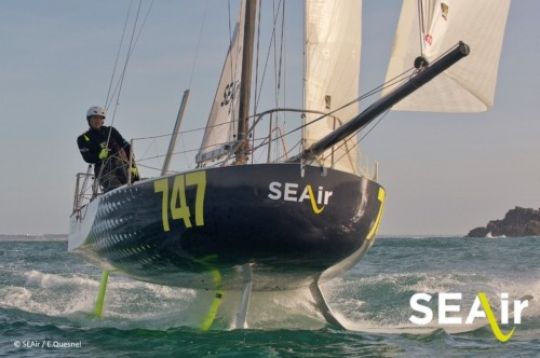
A first Class40 with great success
As a result, Ian Lipinski , who has just joined the Class40 circuit, is looking for an architect to design his boat.
"I went back to being a freelancer. I went back to competitive sailing, my first love."
To support him in his daily work, David Raison calls on a network of partners for digital engineering, structural calculations..
"Depending on the size of the projects, I either get support or work with more or less developed design firms."

To create cruising boats, to make evolve old models
But offshore racing is not the only activity of the architect since he also designed several cruising boats: Rêvolution 22/24 and 29 of the Afep Marine shipyard , or Icemint 40 of the Spanish shipyard Mint Yachts , in collaboration with François Lucas, an aluminum sailboat with lifting keel .
In addition to the creation of new units, one of the activities of the naval architect is the evolution of existing models.
"I've had requests to "recycle" Davy Beaudart's 2014 Flexirub proto. Each time, the manufacturers and customers change. I do some redesigns. In Class40 for example, the following boats evolve or are optimized. There is a lot of work to do!
I also have a great project underway with Felix de Navacelle, a 12.50m offshore cruising scow designed for a private individual. We're trying to find a shipyard and other shipowners."
With the construction of 3 Class40 Raison plans and orders for Maxi 6.50, David Raison hopes to take advantage of the opportunity to develop his practice.
"It's a good opportunity to bring out new units, take orders and grow the practice. The big challenge in our business is going from one to two people, so that's why you have to double the business."
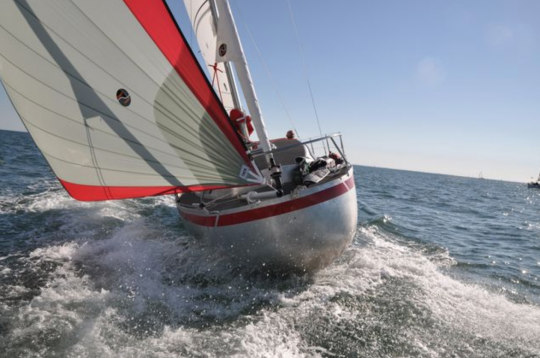
The father of scows
David Raison is known for his scow bows - the round noses - which he has made his trademark and which is now being used in naval architecture .
"I was the first to do this. Today, we're still a long way ahead of the competition on these hulls. We are on our third generation of scow with Ian Lipinski's boat. The 4th generation is under study, while our competitors are at the first generation. They are going through difficulties that we also went through, but they are brilliant people and in 4 or 5 years, we will all be equal on the scow design. We have an experience and a design method different from the others and adapted to this kind of boats.
In Class40, the Lombard firm with the Lift 40 has taken a step forward. Sam Manuard has also advanced the design in this direction with the IMOCA L'Occitane en Provence. He introduced a scow hull and managed to convince people. He has done some very good thinking about the design of the boat and the design of the foils. He brought a novelty with his buffalo horn foils. It's a different approach to flying when the other concepts are quite similar, whether they are L-shaped, C-shaped or circular.
It's going to be interesting to see how the new generation boats will evolve.
In Class40, I am looking forward to the new generation to see the innovations and concepts of my colleagues. What works or not. To know if we are still in the game with this design from 2018. There are 4 scows optimized for the 2020 rules: Etienne Bertrand's Class40 built in Cape Town, the Lombard designs built in Normandy, the VPLP designs at Multiplast and the Pogo 40 S4. It's going to be interesting to see the architects' interpretation of how the boats work and the construction issues.
A boat is always a compromise between a specification and a yard. Behind each line, there is a trade-off between advantages and disadvantages.
What makes a good boat is the elegance, the way it walks well on the water. It has to be a seaworthy and reliable boat. Then it's how well it fits the response to the customer."

Log in or Sign up
You are using an out of date browser. It may not display this or other websites correctly. You should upgrade or use an alternative browser .
The New Scows
Discussion in ' Sailboats ' started by Doug Lord , Mar 15, 2012 .
Doug Lord Flight Ready
Doug Lord said: ↑ Found this in the Mini forum on SA: http://www.youtube.com/watch?feature=player_embedded&v=n1MmjU6Z3tc# ! website from u-tube vid: www.voiliers-revolution.fr From the website microsoft translation: After the victory of David Raison on the Mini-Transat 2011 with his sailboat flat and to bow rounded inspired by the scows Americans, David ROY of the shipyard AFEP Marine specialist construction naval aluminium and Quentin DELOUETTE, creator of the graduate School of Navigation Frenchnetwork officer first class of the school of the Merchant Marine and former skipper sailing, have brought together their skills and their ideas for build the first sailboat pleasure series flat and to bow rounded. The purpose of this dream : revolutionize the pleasure. The idea is to use the volume offered by keel type scow inspired by the Works Team of David reason to provide a true sailboat cruise simple, comfortable and spacious. This sailboat will be fun with a surprising keel and a generous canopy, solid because thick aluminum, going everywhere because dinghy, easy to live with materialsinnovatives requiring little maintenance. At all levels, the Rêvolution 22 will be a surprising sailboat and revolutionary. click on image: Click to expand...
Attached Files:
Scow-rev 22 1.jpg, scow rev 22 2.jpg, scow rev 22 3.jpg.
sean9c Senior Member
Doug Lord said: ↑ =================== Pictures from facebook linked from SA of the sailing version of the Revolution 22-a production(?) version of David Raisons boat: click- Click to expand...
Stephen Ditmore Senior Member
And it's going to slam to a halt every time it hits a wave.
New Scows Stephen Ditmore said: ↑ And it's going to slam to a halt every time it hits a wave. Click to expand...
daiquiri Engineering and Design
It looks so Flash Gordon style. I like it.
Doug Lord said: ---------------- With this success, the qualities of his experimental mini with a round bow, greeted with smile at her first appearance, were clearly demonstrated. Especially the gliding qualities of this design surpass the competitors by far. David Raison is therefore one of the big favorites of the Mini-Transat beginning in September, the highlight of the season for the Minis. All other boats of the 48 participants' fleet were still underway this morning at press time. Click to expand...
picsquallab.jpg
Stephen Ditmore said: ↑ Is the reference to 'gliding' a European usage or funny translation? I don't get it. Perhaps that's what we call 'surfing'? I was never an Optimist sailor but sailed a Boston Whaler squall around Chatham, MA as a kid. I came to wish I could put a pointy extension on the stern and sail the boat the other direction. That bow would make a nice transom. Anyway, at times it sailed quite smartly. Click to expand...
Dyer Dhow dinghy.jpg
Reference is to your post #3 at http://www.boatdesign.net/forums/sailboats/mini-ocean-racing-scow-39114.html , where you quoted Scuttlebut Europe. I tried to get the attribution to read correctly but kept getting weird results and gave up. The experience that made me wary of full bows in waves was aboard a Columbia 34 owned by my best friend's family. Steep sea that day on Nantucket Sound. I think were reaching but the waves were coming at us.
goodwilltoall Senior Member
Bluff bows are an enigma, Cook's Endeavor had one that performed very well during its time for what it was intended to do. Think the key is rounded shapes without hard corners. The article mentions the scow smashing the other designs by 130 miles. Looks can grow on people, high performance make things acceptable and with time it begins to be appreciated. Right now it does look funny like something from the fifties where those types of rounded shapes where meant to instill feelings of aloofness and speed. In this case it really is fast but, being judged by others, while accepting the prize the skipper should keep his head down in shame for the way it looks.
ancient kayaker aka Terry Haines
Info on earlier scows at post #17 here http://www.boatdesign.net/forums/sailboats/new-scows-42298-2.html#post540096
CT 249 Senior Member
goodwilltoall said: ↑ Bluff bows are an enigma, Cook's Endeavor had one that performed very well during its time for what it was intended to do. Think the key is rounded shapes without hard corners. The article mentions the scow smashing the other designs by 130 miles. Looks can grow on people, high performance make things acceptable and with time it begins to be appreciated. Right now it does look funny like something from the fifties where those types of rounded shapes where meant to instill feelings of aloofness and speed. In this case it really is fast but, being judged by others, while accepting the prize the skipper should keep his head down in shame for the way it looks. Click to expand...
sharpii2 Senior Member
Thanks Bob, that was the best justification for what appears at first to be a retrograde design step that I have read. Puts it into perspective!
Paul B Previous Member
sharpii2 said: ↑ Bluff bows are best for down wind work. Sharper bows tend to dig in, when running before a fresh wind, giving the boat more of a tendency to broach. The full, buoyant bow helps prevent this. Click to expand...
- Advertisement:
Scows One thing to remember about scows-at least the original inland lake scows and probably all fast scows- is that they are designed to sail at an angle of heel to keep wetted surface low particularly upwind but also downwind in lighter conditions so the bow does not operate like a normal bow:
E-or A scow upwind.jpg
E-scow to weather.jpg, e-scow spin.jpg.
- No, create an account now.
- Yes, my password is:
- Forgot your password?


Revolution 29, round is beautiful
- September 28, 2022
- No Comments

INNOVATIVE MATERIALS A cruising boat that promises to be fun, featuring a generous sail plan, performance and maneuverability of a dinghy (thanks to the lifting keel you can get almost anywhere), and built with innovative materials with low maintenance costs. The hull is made of aluminum, and extensive use has been made of … cork. The deck covering is made of cork: an environmentally friendly material that is anti-slip, anti-moisture and, at the same time, excellent thermal and acoustic insulation. Also, to clean it, just get a mop or pressure washer once in a while. www.afep-marine.com

Leave a Comment Cancel Reply
Your email address will not be published. Required fields are marked *
This site uses Akismet to reduce spam. Learn how your comment data is processed .

Read the latest issue

Are you already a subscriber?
- Here you can read the e-magazine! >>
- Renew your subscription >>
- Reset your account password >>
Slovenian boat accessories you find on boats halfway around the world
Three tips for changing the sails on your boat, this electric self-tailing winch is also suitable for small boats, shock absorbers that eliminate squeaky tops and make you sleep better, latest announcements, our socials.
You may also be interested

Classic Boat of the 90s: here are three mythical 50-footers (and how much they’re worth)
Classic Boats of Historical Value by Journal of Sailing never stops updating! Twenty new boats have arrived, one step closer to the quota of 300 Classic Boats, which we will soon reach also thanks to your comments and suggestions. In

Three “new” Classic Boats between 13 and 14.5 meters that will increase in value

40-foot Classic Boat? Here are 3 not to be underestimated at all

How much are 11-meter Classic Boats worth? Here are 3, new ones, to find out
Giornale della vela.
Direttore responsabile: Luca Oriani
PER COMUNICARE CON LA REDAZIONE 02 535 811111 – [email protected]
PER LA PUBBLICITÀ Senior account: Guido De Palma: tel. 02 535811208 cell. +39 347 2347433 [email protected].
Pierfrancesco Pugno: cell. +39 3496621980 [email protected]
Cookie policy Privacy policy

INFO ABBONAMENTI, VENDITE DIRETTE E PRODOTTI DIGITALI
tel. 02 535811 111/200 [email protected]
Interesting Sailboats
Thursday, december 6, 2018, revolution 29: a mini voyage boat.


No comments:
Post a comment.

Revolution 29
A unique scow bow makes the revolution 29 spacious and fast.
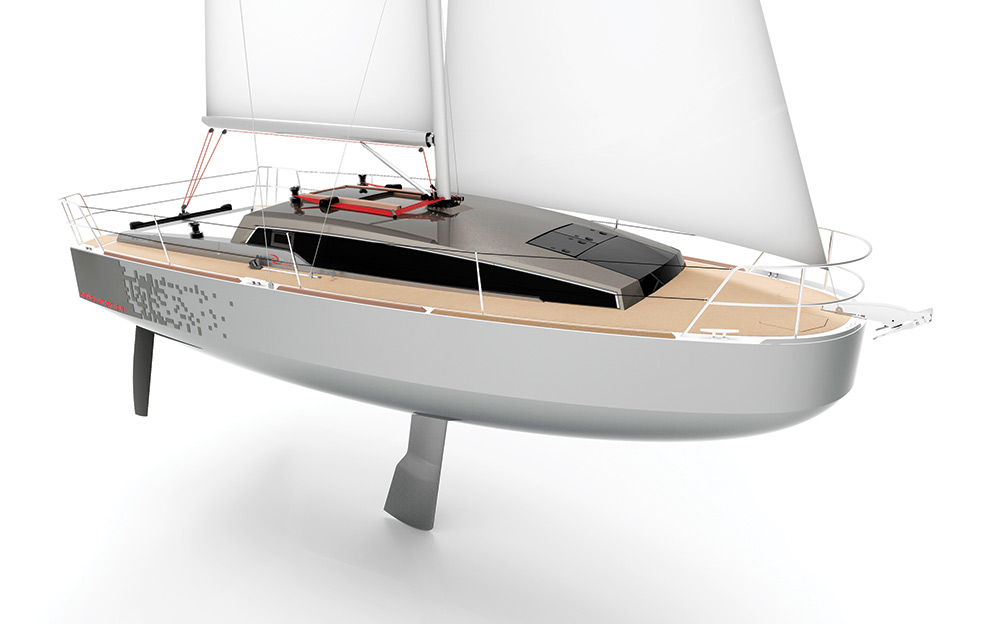
We are going to have some fun this month—there is an interesting trio of boats to review. I don’t know if you have been following the MiniTransat class ocean racers but you should. These little pocket rockets are amazing boats, very extreme and capable of high speeds in the hands of skilled crew. The class is growing rapidly, especially in Europe. Minis use a box-type rule that limits LOA to 21 feet 4 inches, so designers have to look for innovative ways to gain sailing length and power.
Enter the scow bow Minis. At first look I was inclined to think, “Oh God, please don’t make this fast.” But I knew that scow bows have a long and successful history so the chances were strong that this bow would work. It works on the many scow one-design classes and even the old, sedate, CCA rule had Hoot Mon, a scowlike yawl with a successful race record.
It was inevitable that a builder would jump on the scow bow for a family cruising boat. Look at that beam and volume forward. Along came Afep Marine with designer David Raison. Together they have produced the aluminum Revolution 29, along with its 21-foot little sister. It’s funny looking; there’s just no way around that. The ends are snubbed off, there is zero spring to the sheer and the only attractive line I can find on the entire hull is the chine that runs around the bow.
I suspect that the heeled waterlines for this hull would look fairly normal with that chine making a somewhat V-shaped entry. Using 27 feet 2 inches for DWL gives a D/L of 232. This is not a light boat. L/B is 2.53 indicating plenty of beam, as if your eye had not already told you that. Draft with the board down is 5 feet 7 inches and the board-up draft is 2 feet 4 inches. There are twin rudders.
The accommodation plan is pretty amazing considering it is a 29-foot boat. The expansive capital-U-shaped berth has replaced the dreaded V-berth. The bad news is that the U-double berth is an extension of the main cabin settee, so there is no privacy forward. The good news is that it will be very convenient to have breakfast in bed. There is a double quarterberth aft, but it’s pretty tight with just enough standing room to pull on your pants.
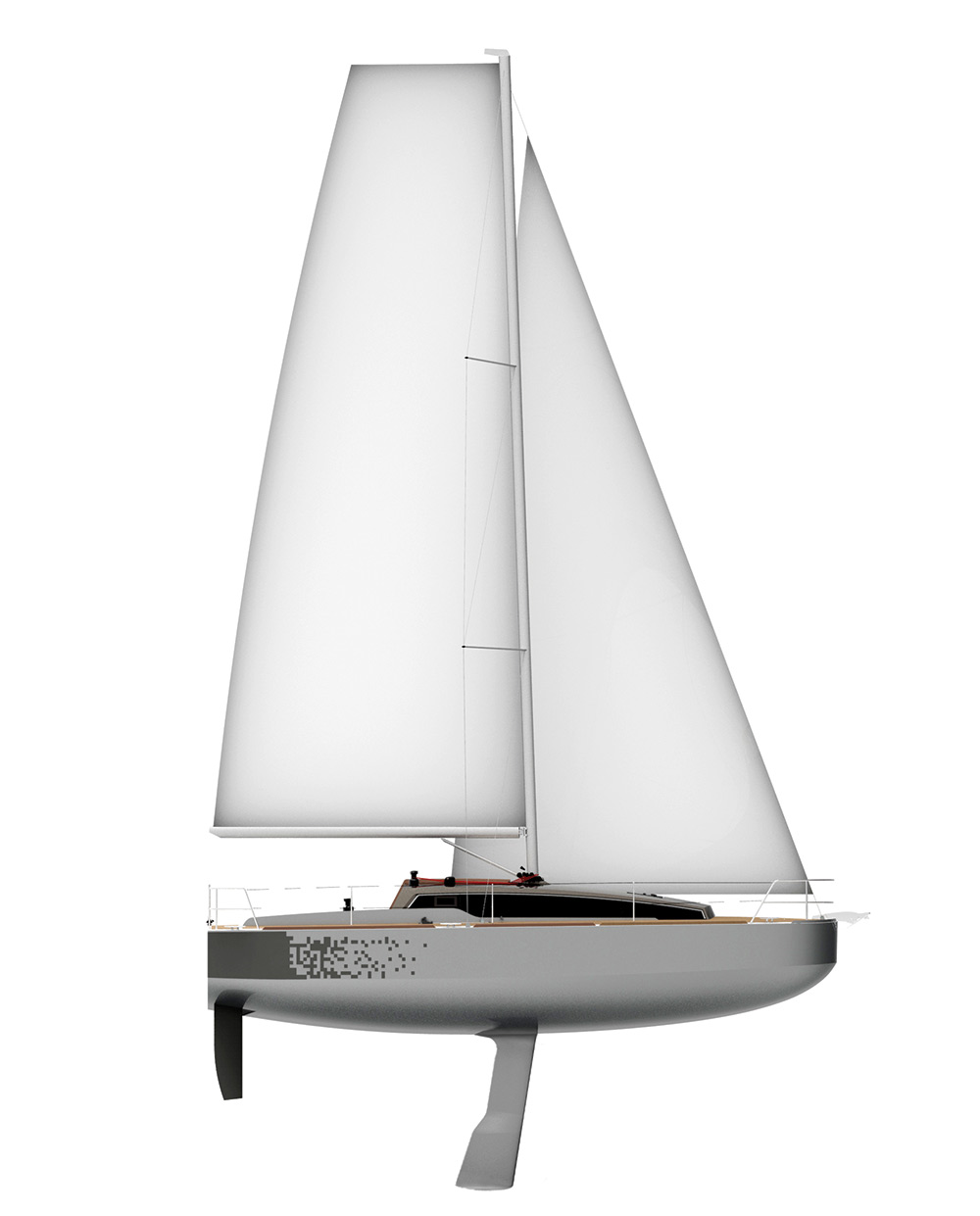
The galley is big for this size boat. I don’t like stoves up against a bulkhead so I would move that stove forward to line up with the forward counter then put counter aft of the stove. I like to be able to put pots either side of the stove. But there is quite a bit of counter space as drawn. There is a forward-facing nav station to starboard and a small but adequate head aft.
I was out racing last weekend and studying the square-topped mainsails in the fleet. The more I looked, the more the shape made sense and the pointy-headed triangular mains began to look silly. Square-topped mainsails mean you can’t have a standing backstay but with enough spreader sweep that’s not a problem. Spreader sweep angle on the Revolution looks to be 28 degrees. The SA/D of the Revolution is 23.37 and that’s plenty of power for some exciting sailing.
One thing for sure is that working on the foredeck will be easy. The headstay is about 20 inches aft of the stem so there is lots of room to work around it. On deck, a retractable sprit can be mounted for the asymmetrical chute. Interestingly, the cap shrouds go to chainplates on the rail. The lower diagonals go to chainplates inboard near the edge of the cabintrunk. This will make it easy to get past the shrouds when you go forward.
I would hope this look provides the owner with blistering speed and sumptuous comfort.
LOA 22’8”; Beam 11’6”; Draft 3’7” (board up), 8’6” (board down); Displ. 8,818 lbs.; Ballast 2,425 lbs.; Sail area 743 sq. ft.; Auxiliary 18-hp diesel; Fuel 11 gal.; Water 66 gal.
Sailaway price: $145,000
Afep Marine
Plateau Nautique
50 Rue Senac de Meilhan
17000 La Rochelle, France
+33 (0) 54 644 81 51
www.afep-marine.com
Also in Perry on Design
- Wallyrocket 51
- Clubswan 28
- Beneteau Oceanis 37.1
- M.A.T. 12.2
- Jeanneau Yachts 55
Also from Robert H. Perry

Revolution 25
- Revolution 23
- Testimonials
Build Your 2024 Custom Revolution 25
We are now taking 2024 orders for the revolution 25. contact us to spec out your revolution 25 and order today .
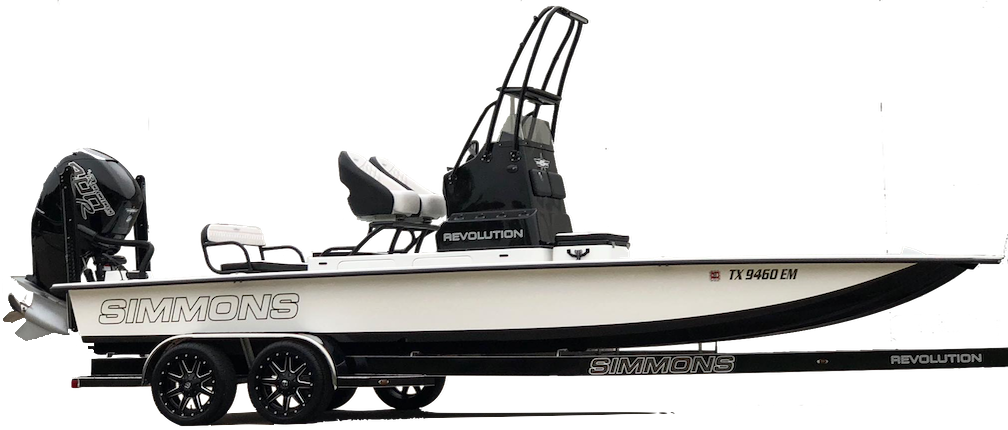
SPECIFICATIONS:
Hull type: cat hull weight: 1800 lbs length: 25’ beam: 8’4” draft: 11” fuel capacity: 80 gallon hp rating: unlimited, revolution 25 standard equipment:, revolution 25 hull w/80gal fuel capacity center console w/(8) rod holders, storage areas & grab handle carbon fiber dash panels w/ mini led push button (8) usb and 12v accessory plugs led navigation/anchor lights insulated livewell w/ fill & pro air ss pull up cleats (5), ss friction hinges & latches auto bilge pumps (2) seadek in storage lockers rear deck rod locker custom bucket seats w/ sliding bases on aluminum frame hydraulic jackplate w/ custom gauge cranking battery 34m house battery 31dm, motor options, mercury racing 450r sm 1.60 mercury racing 400r sm 1.75 mercury racing 300r sm 1.75 mercury 400 verado hd 1.75 mercury 350 verado hd 1.75 mercury racing 250r sm 1.75, controls & prop options, vessel view link, comm module, harness, j-box, steering, race control, hd hub kit prop - bravo 1 fs (250-400hp) prop - max5 st (250-450hp) - required w/450r, trailer option, coastline tandem axle - simmons welded w/alu fenders, custom wheels & tires, std spare, hull options, 80” riser box w/(4)side access doors, insulated livewell & seat cushion mid-tower & 80" deck box w/large top hatch,(2)side access doors, (1)insulated storage, (1) insulated live well & cushion wide gunnel extensions w/rod storage & led lighting, gps options, simrad nss16 evo3 w/ total scan transducer simrad nss12 evo3 w/ total scan transducer simrad go12 xse w/3-1 transducer simrad go9 xse w/3-1 transducer satellite chip - tx, common rigging options, shockwave s5 suspension bases power pole blade anchors wetsounds audio systems minn kota riptide trolling motors lithium ion batteries custom fiberglass color match coolers, cushion & ss strap kit led light strips in storage areas led underwater lighting wade ladder w/flip up step alumimum frame rear bench seat, removable seadek kit-cockpit, front & rear decks - standard layout and details powder coated boat tubing (most colors) low/med burn bar w/optional led light bar tall burn bar w/optional led light bar, seadek step up, collapsable, zip-open shade top contact us for additional rigging options, pricing and orders, * specs and pricing subject to change prior to bulid..
Great choice! Your favorites are temporarily saved for this session. Sign in to save them permanently, access them on any device, and receive relevant alerts.
- Sailboat Guide
Evolution 22
Evolution 22 is a 21 ′ 9 ″ / 6.6 m monohull sailboat designed by Julian Everitt and built by Evolution Yachts Ltd. between 1978 and 1984.

Rig and Sails
Auxilary power, accomodations, calculations.
The theoretical maximum speed that a displacement hull can move efficiently through the water is determined by it's waterline length and displacement. It may be unable to reach this speed if the boat is underpowered or heavily loaded, though it may exceed this speed given enough power. Read more.
Classic hull speed formula:
Hull Speed = 1.34 x √LWL
Max Speed/Length ratio = 8.26 ÷ Displacement/Length ratio .311 Hull Speed = Max Speed/Length ratio x √LWL
Sail Area / Displacement Ratio
A measure of the power of the sails relative to the weight of the boat. The higher the number, the higher the performance, but the harder the boat will be to handle. This ratio is a "non-dimensional" value that facilitates comparisons between boats of different types and sizes. Read more.
SA/D = SA ÷ (D ÷ 64) 2/3
- SA : Sail area in square feet, derived by adding the mainsail area to 100% of the foretriangle area (the lateral area above the deck between the mast and the forestay).
- D : Displacement in pounds.
Ballast / Displacement Ratio
A measure of the stability of a boat's hull that suggests how well a monohull will stand up to its sails. The ballast displacement ratio indicates how much of the weight of a boat is placed for maximum stability against capsizing and is an indicator of stiffness and resistance to capsize.
Ballast / Displacement * 100
Displacement / Length Ratio
A measure of the weight of the boat relative to it's length at the waterline. The higher a boat’s D/L ratio, the more easily it will carry a load and the more comfortable its motion will be. The lower a boat's ratio is, the less power it takes to drive the boat to its nominal hull speed or beyond. Read more.
D/L = (D ÷ 2240) ÷ (0.01 x LWL)³
- D: Displacement of the boat in pounds.
- LWL: Waterline length in feet
Comfort Ratio
This ratio assess how quickly and abruptly a boat’s hull reacts to waves in a significant seaway, these being the elements of a boat’s motion most likely to cause seasickness. Read more.
Comfort ratio = D ÷ (.65 x (.7 LWL + .3 LOA) x Beam 1.33 )
- D: Displacement of the boat in pounds
- LOA: Length overall in feet
- Beam: Width of boat at the widest point in feet
Capsize Screening Formula
This formula attempts to indicate whether a given boat might be too wide and light to readily right itself after being overturned in extreme conditions. Read more.
CSV = Beam ÷ ³√(D / 64)
Cruiser racer with fully retractable keel (locked down for sailing) allows the boat to float in only 10” of water and take the ground upright. Some have a masthead rig. Images supplied by the designer.
Embed this page on your own website by copying and pasting this code.
- About Sailboat Guide
©2024 Sea Time Tech, LLC
This site is protected by reCAPTCHA and the Google Privacy Policy and Terms of Service apply.
REVOLUTION 22
Ref : FRMAL334257
Technical sheet
Builder : Afep marine
Life Raft : Yes
Year : 2013
Beam : 2,87 m
hull : Monohull
Material : Aluminum
Length : 6,80 m
keel : Centerboard heavy keel
Draft : 0,50 m
Engine : honda
Shaft : Outboarder
Power Unit. (CV) : 40
Fuel : Gas/petrol
Montage : HB (OB)
Engine(s) : 1
Double Cabin : 1
Sailor Cabin : 0
WC : Chemical
Limitation of liability : XBOAT presents the details of the boat as supplied to us by the owner. Owners may make errors or changes without notifying us. This information is not contractual and does not bind XBOAT in any way. It cannot be opposed by a visitor or a buyer.
Xboat offers you its expertise and estimates your boat.
Xboat will find you a buyer quickly and at the best price, thanks to its wide network of agents and its powerful computer system.
Evolution 22
The evolution 22 is a 21.75ft masthead sloop designed by julian everitt and built in fiberglass by evolution yachts ltd. (uk) between 1978 and 1984., 90 units have been built..
The Evolution 22 is a moderate weight sailboat which is slightly under powered. It is stable / stiff and has a low righting capability if capsized. It is best suited as a day-boat.
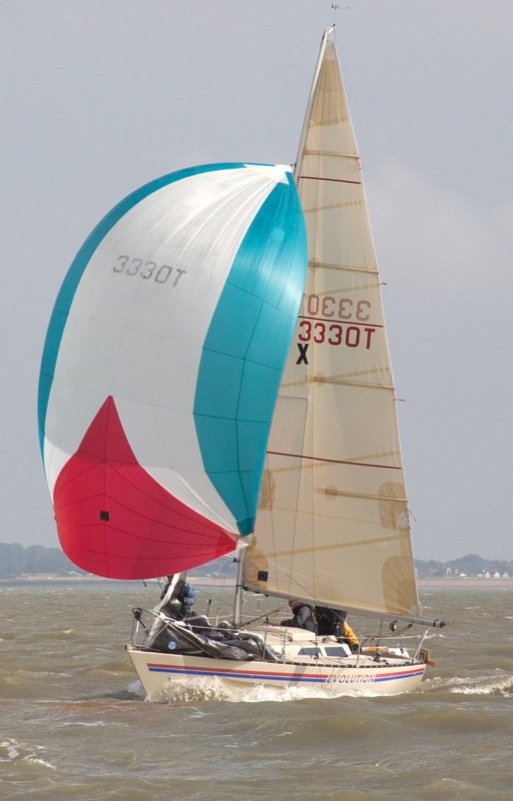
Evolution 22 for sale elsewhere on the web:

Main features
Login or register to personnalize this screen.
You will be able to pin external links of your choice.

See how Sailboatlab works in video

We help you build your own hydraulic steering system - Lecomble & Schmitt
Accommodations
Builder data, other photos.
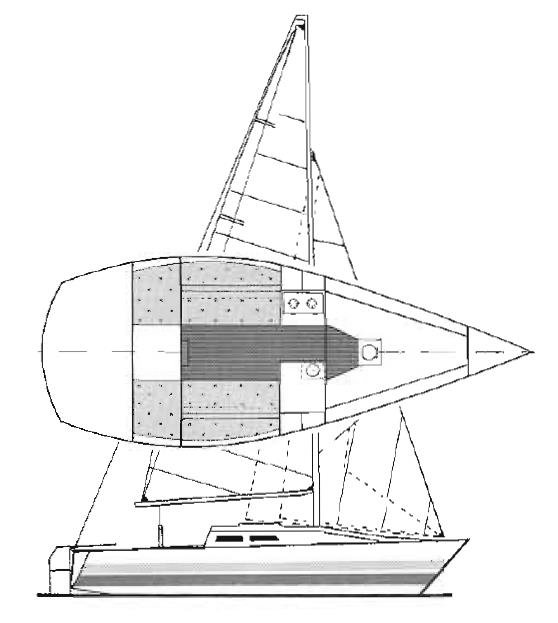
Modal Title
The content of your modal.
Personalize your sailboat data sheet
Evolution 22
Evolution 22 - Vela 77 / STW002494
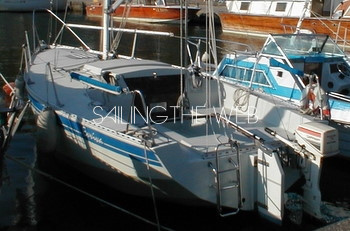
cabin cruiser
cruising/regatta
overall length
hull length
waterline length
standard draft
minimum draft
displacement
diesel tank
mast height
Accomodation layouts
standard version
DOCUMENTS: Evolution 22

If you find some wrong or lacking data of this boat, you can propose an update.
Technical forum: evolution 22, note: you will be redirected to another website., support the ultimate sailboat database.
The contents on this website, which today you can simply consult and use, have been collected, organized and archived by people who worked and invested in this project with passion and dedication for many years.
Before proceeding to browse, support our archive with a small donation that will allow us to maintain and improve this project.
proceed, I will donate next time
To proceed, you need to sign-in

IMAGES
VIDEO
COMMENTS
3rd AFEP scow signed Raison . Launched with the Revolution 22 in 2012, the range of scow-bowed sailboats from the AFEP shipyard in La Rochelle continues to expand. Still backed by architect David Raison, renowned for his Mini 6.50s, the builder then developed the Revolution 29, and in 2021 will present the third, intermediate model, the Revolution 24, a 7.25-meter-long, 2.89-meter-wide yacht.
Le Rêvolution 22 est construit en aluminium semi épais: 6 mm pour la coque et 5 mm pour le pont et le roof. Cela fait du Rêvolution 22 un voilier qui n'a peur de rien. Résistant, solide et léger, l'aluminium est le matériau idéal pour un voilier de croisière. Pour la sécurité, une crash box est présente à l'avant, formée par la ...
Interior of the Revolution 29. A whole lot of space for a boat this small. Note there is also a predecessor design, the Revolution 22, more directly based on the 22-foot racing Mini. But putting a scow bow on a cruising boat obviously doesn't instantly make it a "cruiser-racer.". What makes the scow bow super-competitive is that it ...
News flash from Salon Nautic de Paris 2012. See the spectacular Revolution 22. The boat on the show is a replica of the mini-transat winner 2011. That boat w...
A boat with a BN of 1.6 or greater is a boat that will be reefed often in offshore cruising. Derek Harvey, "Multihulls for Cruising and Racing", International Marine, Camden, Maine, 1991, states that a BN of 1 is generally accepted as the dividing line between so-called slow and fast multihulls.
This mini-cruiser may look quirky, even extraordinary, but wait till you see the space it provides below decks. Toby Hodges steps aboard from the Revolution ...
The Rêvolution 24 is a moderate weight sailboat which is a very high performer. It is stable / stiff and has a low righting capability if capsized. It is best suited as a racing boat. ... 286.22 Comfort ratio: 18.07 ...
The Revôlution 22 The father of scows . David Raison is known for his scow bows - the round noses - which he has made his trademark and which is now being used in naval architecture. "I was the first to do this. Today, we're still a long way ahead of the competition on these hulls. We are on our third generation of scow with Ian Lipinski's boat.
This sailboat will be fun with a surprising keel and a generous canopy, solid because thick aluminum, going everywhere because dinghy, easy to live with materialsinnovatives requiring little maintenance. At all levels, the Rêvolution 22 will be a surprising sailboat and revolutionary. click on image:
After the Revolution 22, the first production boat with a rounded prow, built by AFEP Marine with the collaboration of David Raison (the creator of 747 Teamwork, winner of the Mini Transat, a hull later passed into the hands of Giancarlo Pedote), the La Rochelle shipyard is back on track, again together with Raison, with the Revolution 29.
The Revolution 29 comes standard with a 18hp engine with 30hp option, a 100L diesel tank and a 90L water tank, with space for a supplementary water tank if needed. It has two cabins, being the frontal one open to the saloon with the possibility of being closed and a huge space for storage, on the back of the boat and a bit everywhere.
Very interesting boat but not that big of a revolution only new thing is the scow hull and the more space that results by that. ... There is a rêvolution 22, that was launched in 2012. Santanasailor Charter Member. Scow Mafia. 1,476 819 North Louisiana. Nov 26, 2021
J/22 is built for safety with buoyancy tanks and offshore hatches. Her 700 lb. lead keel lowers the center of gravity, creating nearly 1700 foot pounds of righting moment at 90 degrees of heel. There are over 1,650 J/22's now sailing in 65 active fleets in eighteen countries on three continents. Recognized by the ISAF, the International J/22 ...
The SA/D of the Revolution is 23.37 and that's plenty of power for some exciting sailing. One thing for sure is that working on the foredeck will be easy. The headstay is about 20 inches aft of the stem so there is lots of room to work around it. On deck, a retractable sprit can be mounted for the asymmetrical chute.
A 4-5kw electric engine would be suitable for this size. 5kwh battery may be enough for electric cooking, but bigger battery is more engine range while providing plenty of electric comforts, and a worthwhile upgrade. They may have missed the mark by not doing electric on this boat. There is a lot of space there.
There is a new entry in production at the well-known Muggiò-based boatyard: the R-Evolution 26. Where "Evolution" and "Revolution" are the marketing terms for the innovative features of this compact inflatable, which repliocates the lines of a successful range that has been well confirmed in the two previous models: the R-Evolution 35 e R-Evolution X-36, the latter equipped with a ...
SPECIFICATIONS: Hull Type: Cat Hull Weight: 1800 lbs Length: 25' Beam: 8'4" Draft: 11" Fuel Capacity: 80 Gallon HP Rating: Unlimited. REVOLUTION 25 Standard Equipment: Revolution 25 Hull w/80gal fuel capacity Center Console w/(8) rod holders, storage areas & grab handle Carbon Fiber Dash Panels w/ Mini LED Push Button (8) USB and 12v Accessory Plugs LED Navigation/Anchor Lights ...
This video is about the things we have done to make cruising on "Seanachai," our 1986 Catalina 22, more comfortable, also where we stow things, and how we ke...
Evolution 22 is a 21′ 9″ / 6.6 m monohull sailboat designed by Julian Everitt and built by Evolution Yachts Ltd. between 1978 and 1984. ... The lower a boat's ratio is, the less power it takes to drive the boat to its nominal hull speed or beyond. Read more. Formula. D/L = (D ÷ 2240) ÷ (0.01 x LWL)³
REVOLUTION 22 - 2013 - 30000.000000 - Afep marine Technical sheet. Xboat. My account . Sailboats; Motorboats; Good deals Motorboats; ... Xboat offers you its expertise and estimates your boat. I'm going for it. Sell. Xboat will find you a buyer quickly and at the best price, thanks to its wide network of agents and its powerful computer system ...
It accomodates 6 people in 2 cabins plus salon. The Rêvolution 29 is a moderate weight sailboat which is a very high performer. It is stable / stiff and has a low righting capability if capsized. It is best suited as a fast cruiser. The fuel capacity is originally small. There is a very short water supply range.
The Evolution 22 is a 21.75ft masthead sloop designed by Julian Everitt and built in fiberglass by Evolution Yachts Ltd. (UK) between 1978 and 1984. 90 units have been built. The Evolution 22 is a moderate weight sailboat which is slightly under powered. It is stable / stiff and has a low righting capability if capsized.
The Evolution 22 produced by the builder Vela 77 and designed by Julian Everitt, is a cabin cruiser for cruising/regatta, rigged Sloop ... read more on Sailing The Web, the ultimate sailboat database ... If you find some wrong or lacking data of this boat, you can propose an update. TECHNICAL FORUM: Evolution 22. Login to ask questions.